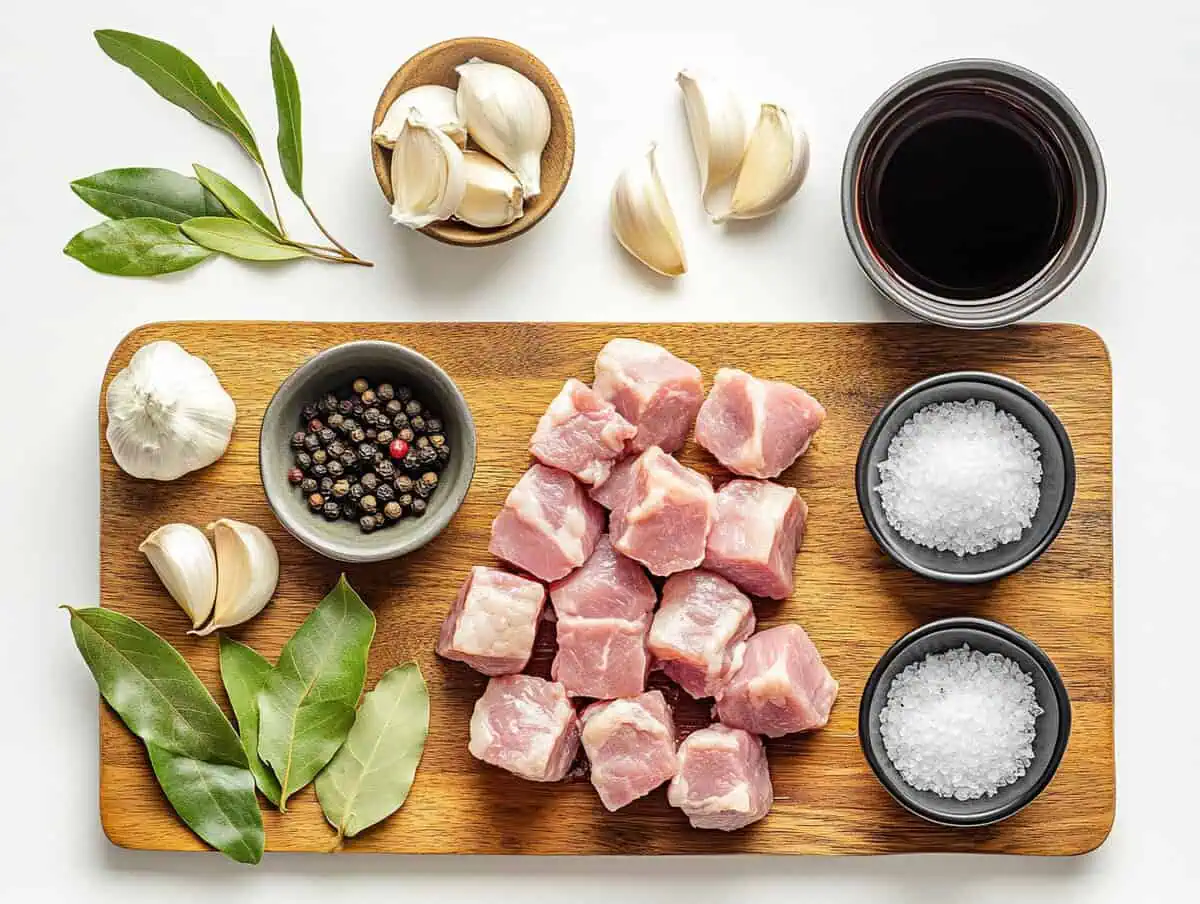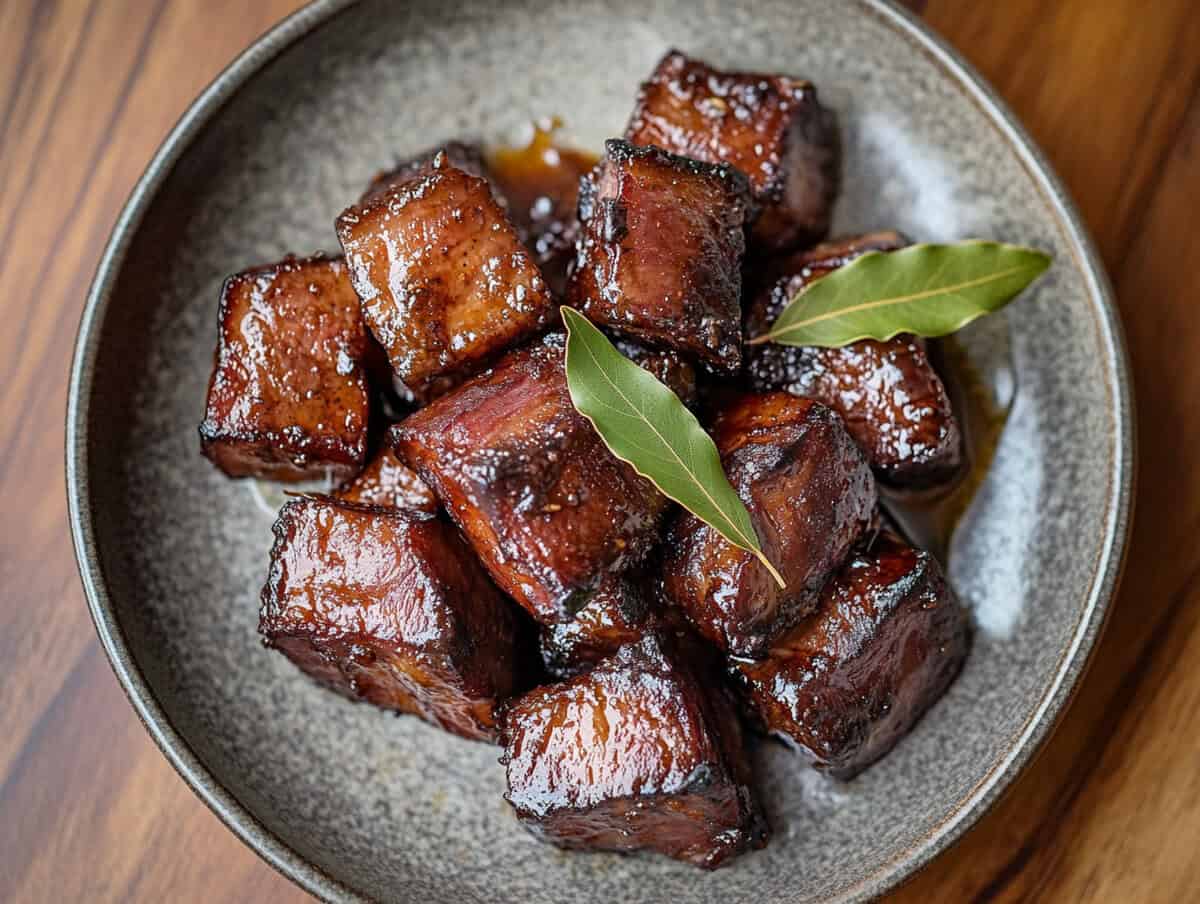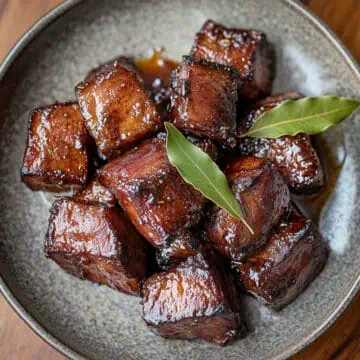Welcome to Kusina Secrets! Today I'm sharing my family's treasured Pork Adobong Tagalog recipe that has been perfected over generations. After years of experimenting with different techniques, I've found the secret to creating that irresistible balance of savory soy sauce, tangy vinegar, and tender pork that melts in your mouth.
This Filipino comfort food staple is surprisingly simple to make with just a handful of ingredients, but delivers incredible depth of flavor that will have everyone asking for seconds. My version keeps the authentic taste while making the process foolproof, even if you've never cooked Filipino food before.
Jump to:
Why You'll Love This Recipe
This Pork Adobong Tagalog recipe is a game-changer for your weekly meal rotation because:
- It uses simple, everyday ingredients that create extraordinary flavor
- The one-pot cooking method means minimal cleanup
- Leftovers taste even better the next day as flavors continue to develop
- It's a budget-friendly dish that stretches your grocery dollars
- The recipe is flexible and forgiving - perfect for both beginners and experienced cooks
Ingredients
I've carefully selected these ingredients to create the perfect balance of flavors in this Adobong Tagalog. Pork belly provides rich, melt-in-your-mouth texture, while the combination of soy sauce and vinegar creates that distinctive adobo tang.
Garlic and onions form the aromatic base that Filipinos love, and bay leaves with peppercorns add subtle depth without overwhelming the dish. The optional brown sugar rounds everything out with just a hint of sweetness to balance the savory and sour notes.

- 500 grams pork belly (liempo), cut into 1-inch cubes
- 200 ml soy sauce
- ¼ cup white vinegar (adjust to taste)
- 6 cloves garlic, minced
- 1 medium onion, sliced
- 3 bay leaves
- 1 teaspoon black peppercorns
- ½ teaspoon salt (adjust to taste)
- 1 tablespoon cooking oil
- 1 cup water
- 1 tablespoon brown sugar (optional)
Equipment
- Large bowl for marinating
- Heavy-bottomed pot or deep skillet
- Sharp knife
- Cutting board
- Measuring cups and spoons
- Wooden spoon or heat-resistant spatula

How To Make
- Marinate the pork: Place pork belly cubes in a large bowl and pour soy sauce over them. Mix well to ensure all pieces are coated. Cover and refrigerate for at least 1 hour, or overnight for deeper flavor.
- Prepare the aromatics: Heat oil in a large pot or deep skillet over medium heat. Add minced garlic and sauté until golden brown, about 1-2 minutes. Add sliced onions and continue cooking until translucent and aromatic, about 3-4 minutes.
- Cook the pork: Add the marinated pork (including the soy sauce marinade) to the pot. Sauté for 5 minutes, stirring occasionally until the pork begins to brown slightly.
- Add remaining ingredients: Pour in the vinegar (DO NOT STIR immediately after adding vinegar - this is a Filipino cooking technique). Add bay leaves, black peppercorns, water, and brown sugar (if using). Let the mixture come to a boil without stirring.
- Simmer: Once boiling, lower the heat, stir everything together, and cover. Simmer for about 30-35 minutes or until the pork is tender and the sauce has reduced.
- Adjust seasoning: Taste and adjust with salt, pepper, or additional vinegar as needed. If you prefer a drier adobo, continue simmering uncovered until the sauce reaches your desired consistency.
- Serve: Remove bay leaves and serve hot with steamed white rice.

Tips from Lola's Kitchen
- Perfect your sauce: The ideal adobo has a balance of salty, tangy, and slightly sweet flavors. Don't be afraid to adjust the soy sauce, vinegar, and optional sugar until you find the perfect balance.
- Never rush adobo: The secret to exceptional adobo is slow cooking. Allow the flavors to develop and the meat to become tender.
- Choose the right cut: Pork belly is traditional for its rich flavor and melt-in-your-mouth texture, but you can use pork shoulder for a leaner option.
- Enhance with aromatics: For deeper flavor, crush the peppercorns slightly before adding them to release their essential oils.
- Make ahead: Adobo tastes even better the next day after the flavors have had time to meld together.
Substitutions
- Protein options: Substitute pork with chicken, beef, or even firm tofu for a vegetarian version.
- Soy sauce alternatives: Use coconut aminos or tamari for a gluten-free option. Reduce sodium by using low-sodium soy sauce.
- Vinegar variations: White vinegar is traditional, but apple cider vinegar, rice vinegar, or cane vinegar can offer subtle flavor differences.
- Add sweetness: Brown sugar is optional but adds depth. You can substitute with honey, coconut sugar, or omit entirely for a more savory dish.
- Make it spicy: Add bird's eye chilies or a dash of red pepper flakes for a spicy kick.
Troubleshooting
- Meat too tough? Cook longer on lower heat. Pork belly should be fork-tender when done.
- Too salty? Add a peeled, quartered potato to absorb excess salt, then remove before serving. You can also add more water and a splash of vinegar.
- Too sour? Balance with a bit more brown sugar or a drizzle of honey.
- Sauce too thin? Simmer uncovered to reduce, or add a small cornstarch slurry (1 teaspoon cornstarch mixed with 1 tablespoon water).
- Sauce too thick? Add water, a little at a time, until you reach your desired consistency.
Storage & Reheating
- Refrigeration: Store leftover adobo in an airtight container for up to 4 days. The flavor will actually improve after a day in the refrigerator.
- Freezing: Adobo freezes exceptionally well. Portion into freezer-safe containers and freeze for up to 3 months.
- Reheating: Warm refrigerated adobo in a covered pot over medium-low heat, adding a splash of water if needed. For frozen adobo, thaw overnight in the refrigerator before reheating.
- Repurposing leftovers: Shred leftover meat and use in fried rice, sandwiches, or tacos for delicious next-day meals.

FAQ
What makes Adobong Tagalog different from other adobo styles?
Adobong Tagalog typically uses both soy sauce and vinegar as its main liquid ingredients, distinguishing it from other regional variations that might use more vinegar or coconut milk.
Can I use a different cut of pork?
Yes! While pork belly gives the richest flavor, you can use pork shoulder or pork loin for a leaner option. Just adjust cooking time accordingly as leaner cuts may cook faster.
Why shouldn't I stir right after adding vinegar?
This is a traditional technique that allows the vinegar to cook briefly undisturbed, which helps mellow its harsh acidity before incorporating it with the other ingredients.
Is adobo better served immediately or the next day?
While delicious immediately, adobo is famously better the next day after the flavors have had time to develop further. This makes it an excellent make-ahead dish.
What's the best way to serve adobo?
Traditionally, adobo is served with steamed white rice. For a complete meal, pair with a side of steamed or sautéed vegetables.
Related
Looking for other recipes like this? Try these:

Pork Adobong Tagalog
Ingredients
- 500 grams pork belly liempo, cut into 1-inch cubes
- 200 ml soy sauce
- ¼ cup white vinegar adjust to taste
- 6 cloves garlic minced
- 1 medium onion sliced
- 3 bay leaves
- 1 teaspoon black peppercorns
- ½ teaspoon salt adjust to taste
- 1 tablespoon cooking oil
- 1 cup water
- 1 tablespoon brown sugar optional
Instructions
- Marinate the pork: Place pork belly cubes in a large bowl and pour soy sauce over them. Mix well to ensure all pieces are coated. Cover and refrigerate for at least 1 hour, or overnight for deeper flavor.
- Prepare the aromatics: Heat oil in a large pot or deep skillet over medium heat. Add minced garlic and sauté until golden brown, about 1-2 minutes. Add sliced onions and continue cooking until translucent and aromatic, about 3-4 minutes.
- Cook the pork: Add the marinated pork (including the soy sauce marinade) to the pot. Sauté for 5 minutes, stirring occasionally until the pork begins to brown slightly.
- Add remaining ingredients: Pour in the vinegar (DO NOT STIR immediately after adding vinegar - this is a Filipino cooking technique). Add bay leaves, black peppercorns, water, and brown sugar (if using). Let the mixture come to a boil without stirring.
- Simmer: Once boiling, lower the heat, stir everything together, and cover. Simmer for about 30-35 minutes or until the pork is tender and the sauce has reduced.
- Adjust seasoning: Taste and adjust with salt, pepper, or additional vinegar as needed. If you prefer a drier adobo, continue simmering uncovered until the sauce reaches your desired consistency.
- Serve: Remove bay leaves and serve hot with steamed white rice.
Tips from Lola's Kitchen
- Perfect your sauce: The ideal adobo has a balance of salty, tangy, and slightly sweet flavors. Don't be afraid to adjust the soy sauce, vinegar, and optional sugar until you find the perfect balance.
- Never rush adobo: The secret to exceptional adobo is slow cooking. Allow the flavors to develop and the meat to become tender.
- Choose the right cut: Pork belly is traditional for its rich flavor and melt-in-your-mouth texture, but you can use pork shoulder for a leaner option.
- Enhance with aromatics: For deeper flavor, crush the peppercorns slightly before adding them to release their essential oils.
- Make ahead: Adobo tastes even better the next day after the flavors have had time to meld together.
The Story Behind Pork Adobong Tagalog
Adobong Tagalog holds a special place in Filipino cuisine as our unofficial national dish. The word "adobo" actually comes from the Spanish term "adobar," meaning to marinate or season. When Spanish colonizers arrived in the Philippines in the 16th century, they observed locals cooking meat in vinegar and named it after their own similar preservation technique. However, Filipino adobo predates Spanish influence by centuries!
Long before refrigeration existed, our ancestors needed ways to preserve meat in the tropical Philippine climate. They discovered that cooking meat in vinegar and salt not only extended its shelf life but created incredibly flavorful dishes. This preservation method was perfect for the hot, humid conditions of the islands, allowing families to prepare food that would remain edible for several days.
What makes Adobong Tagalog distinctive is the addition of soy sauce, which came later through Chinese traders and became a staple ingredient in Luzon (the Tagalog region). This dark, umami-rich sauce gives Tagalog-style adobo its characteristic brown color and depth of flavor that sets it apart from other regional varieties. Some southern Filipino versions skip soy sauce entirely, relying solely on vinegar, salt, and spices.
Every Filipino family has their own cherished adobo recipe with slight variations. Some add coconut milk for creaminess, others include turmeric for color, and many debate whether it should be saucy or reduced to a thick glaze. My version stays true to the classic Tagalog preparation while incorporating little techniques I've learned from years of making this beloved dish.
What's fascinating about adobo is how it embodies Filipino food philosophy – the perfect balance of salty, sour, and slightly sweet flavors that makes our cuisine so distinctive. The dish also represents our cultural history, showing how we've adapted influences from Spanish, Chinese, and native cooking traditions to create something uniquely Filipino.
Today, Pork Adobong Tagalog can be found in Filipino homes worldwide, from Manila to New York, each family adding their personal touch while maintaining its soul-satisfying essence. It's comfort food that tells the story of our resourceful ancestors, colonial history, and the enduring culinary heritage that continues to bring families together around the dinner table.










Comments
No Comments